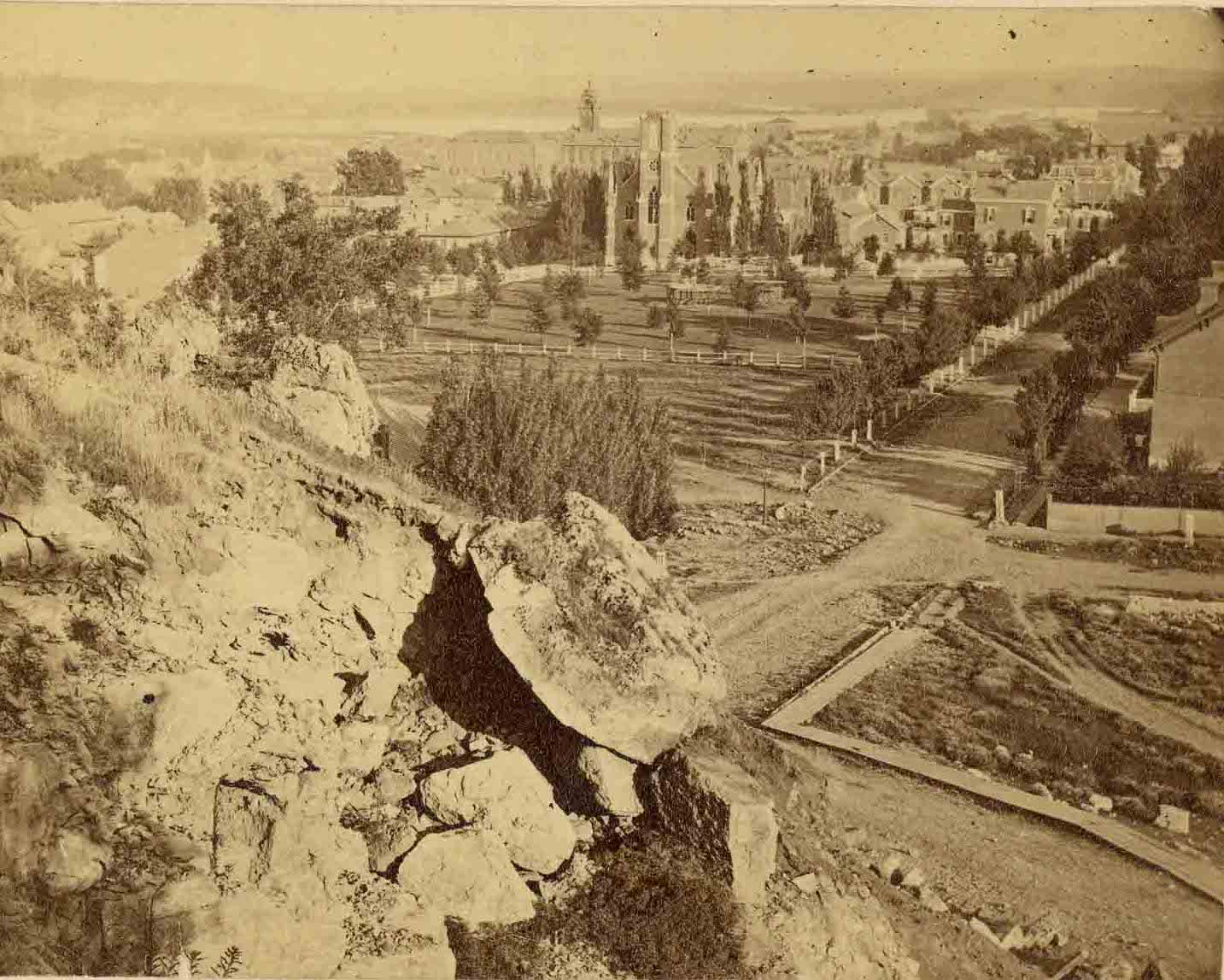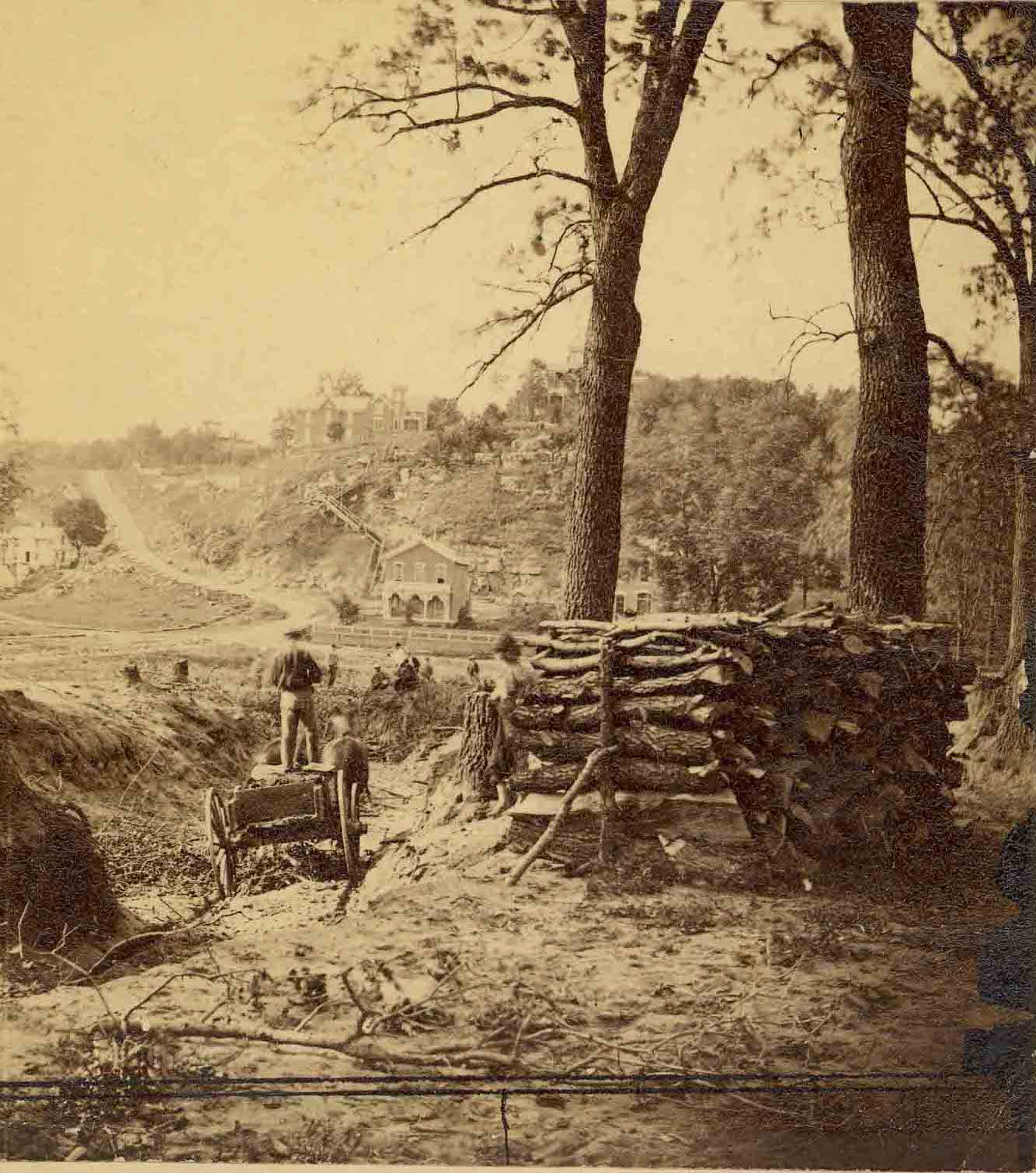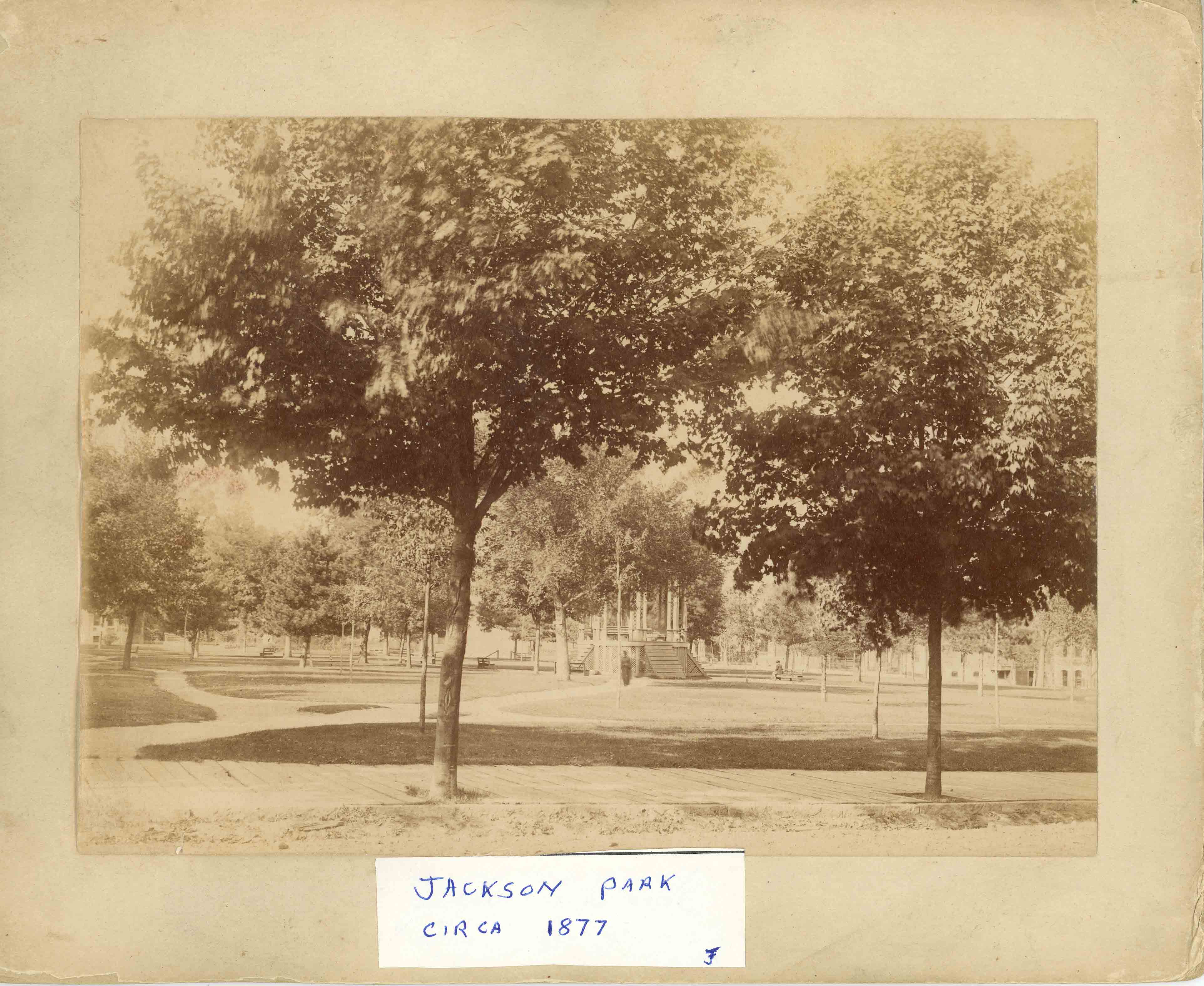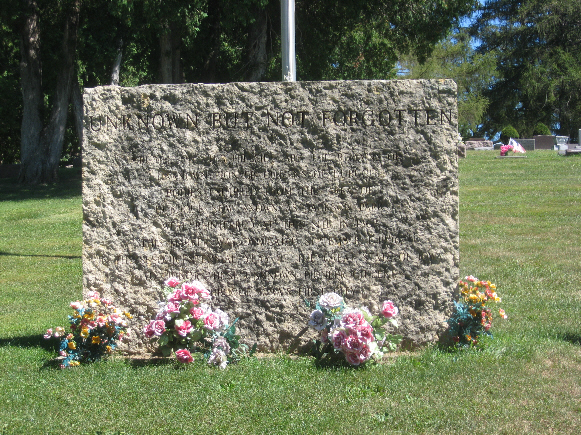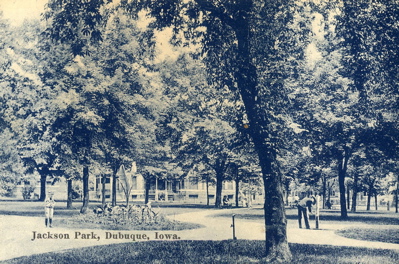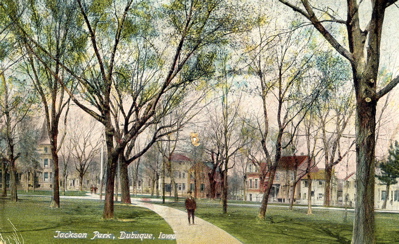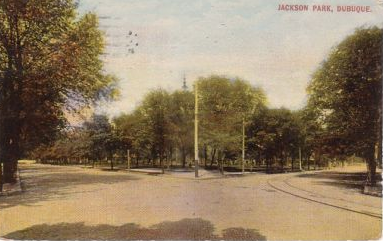Encyclopedia Dubuque
"Encyclopedia Dubuque is the online authority for all things Dubuque, written by the people who know the city best.”
Marshall Cohen—researcher and producer, CNN
Affiliated with the Local History Network of the State Historical Society of Iowa, and the Iowa Museum Association.
JACKSON PARK: Difference between revisions
No edit summary |
No edit summary |
||
| Line 1: | Line 1: | ||
[[File:JacksonPark2 copy.jpg|150px|thumb|left|View of Jackson Park from North Main. Photo courtesy: National Mississippi River Museum and Aquarium]]JACKSON PARK. Dubuque's first designated cemetery. The area now known as Jackson Park was used as a cemetery beginning with the early settlement in 1833 and was fenced by subscription. (1) | [[File:JacksonPark2 copy.jpg|150px|thumb|left|View of Jackson Park from North Main. Photo courtesy: National Mississippi River Museum and Aquarium]]JACKSON PARK. Dubuque's first designated cemetery. The area now known as Jackson Park was used as a cemetery beginning with the early settlement in 1833 and was fenced by subscription. (1) | ||
| Line 28: | Line 26: | ||
[[File:JacksonPark1.jpg|200px|thumb|left|Pagoda with steep steps in seen among the trees of Jackson Park. Photo courtesy: National Mississippi River Museum and Aquarium]] | [[File:JacksonPark1.jpg|200px|thumb|left|Pagoda with steep steps in seen among the trees of Jackson Park. Photo courtesy: National Mississippi River Museum and Aquarium]] | ||
To improve Jackson Square a music stand or pagoda in the park similar to the one planned for Washington Square was constructed in 1877. ( | To improve Jackson Square a music stand or pagoda in the park similar to the one planned for Washington Square was constructed in 1877. (5) Heer and Naesher won the contract for the $150 building project. Ten people donated funds. The stairs on the pagoda were steep and without railings. Presidential candidate James G. Blaine declined to use the Jackson Park pagoda for a speech in late 1878. Instead he used an A. A. Cooper wagon bed. The newspapers chuckled that a Republican had stood on a “Democratic platform” to give his speech. (6) The pagoda was available for band use only and sitting in it was prohibited. (7) | ||
Both parks Washington and Jackson parks have served as the sites for an impressive array of events, including musical concerts, and educational programs. One rather curious program conducted in Jackson Park in 1895 was a stereoscopic show by Professor J. A. Wilson, who represented the Afro-American Department of the Atlanta Exposition. ( | Both parks Washington and Jackson parks have served as the sites for an impressive array of events, including musical concerts, and educational programs. One rather curious program conducted in Jackson Park in 1895 was a stereoscopic show by Professor J. A. Wilson, who represented the Afro-American Department of the Atlanta Exposition. (8) In recent years, the "Music in the Parks" program has offered families free entertainment from local groups and individuals. (9)Curiously the parks were not simply available for any public use and the early years are filled with complaints of inadequate benches, those available being located within the park and not on the outer street fronts, and usually filled with "riffraff" who intimidated "proper ladies." (10) | ||
The pagoda, dedicated by Congressman [[HENDERSON, David B.|David B. HENDERSON]] in mid-September, 1877, was an immediate favorite of the neighborhood. ( | The pagoda, dedicated by Congressman [[HENDERSON, David B.|David B. HENDERSON]] in mid-September, 1877, was an immediate favorite of the neighborhood. (11) Due to neglect, however, the structure lasted only twenty years before it was torn down and sold for scrap. A memorial fountain to honor Judge [[LACY, Benjamin William|Benjamin William LACY]] was added to the park in 1913. (12) | ||
[[Image:fountain.jpg|left|thumb|250px|This monument in Jackson Park showing Potosa was part of a fountain given in 1913 to Judge Benjamin Lacy by his three sons. Photo courtesy: http://dubuque-tour.tripod.com/]] | [[Image:fountain.jpg|left|thumb|250px|This monument in Jackson Park showing Potosa was part of a fountain given in 1913 to Judge Benjamin Lacy by his three sons. Photo courtesy: http://dubuque-tour.tripod.com/]] | ||
In 1966 a proposal was made to the Dubuque Park Board to sell Jackson Park as the site of a new [[DUBUQUE BOYS' CLUB]] building. Directors of the Boys' Club had suggested they waned to use about one-seventh of the land for the new building. On February 10, 1966 the idea was rejected by the park board with two members voting against the proposal and one abstaining. After the vote, the chairman of the board expressed the idea that the board should discuss the purchase of the land with representatives of [[SAINT PATRICK'S CATHOLIC CHURCH]]. Board members conceded the park had not been kept up, but that was because of a lack of funds. ( | In 1966 a proposal was made to the Dubuque Park Board to sell Jackson Park as the site of a new [[DUBUQUE BOYS' CLUB]] building. Directors of the Boys' Club had suggested they waned to use about one-seventh of the land for the new building. On February 10, 1966 the idea was rejected by the park board with two members voting against the proposal and one abstaining. After the vote, the chairman of the board expressed the idea that the board should discuss the purchase of the land with representatives of [[SAINT PATRICK'S CATHOLIC CHURCH]]. Board members conceded the park had not been kept up, but that was because of a lack of funds. (13) | ||
[[File:unknown.jpg|200px|thumb|left|The grave stone erected in 1996.]] | [[File:unknown.jpg|200px|thumb|left|The grave stone erected in 1996.]] | ||
| Line 67: | Line 65: | ||
4. Ibid. Online: http://www.ebooksread.com/authors-eng/franklin-t-oldt/history-of-dubuque-county-iowa-being-a-general-survey-of-dubuque-county-histor-tdl/page-13-history-of-dubuque-county-iowa-being-a-general-survey-of-dubuque-county-histor-tdl.shtml | 4. Ibid. Online: http://www.ebooksread.com/authors-eng/franklin-t-oldt/history-of-dubuque-county-iowa-being-a-general-survey-of-dubuque-county-histor-tdl/page-13-history-of-dubuque-county-iowa-being-a-general-survey-of-dubuque-county-histor-tdl.shtml | ||
5. Jacobsen, James E. '''Jackson Park Historic District Phase IV District Report''', 2003, p. 6 | |||
6. Ibid. | |||
7. Ibid., p. 7 | |||
8. Ibid. | |||
9. "Music in Jackson Park." Online: http://www.sustainabledubuque.org/index.cfm/51784/49505/music_in_jackson_park | |||
10. Jacobsen, p. 7 | |||
11. Schaffer, James L. and Tigges, John. Dubuque: The 20th Century. Arcadia Publishing Company, 2000, p. 33 | |||
12. Jacobsen, p. 7 | |||
13. Thompson, Dave. "Use of Jackson Park by Boys' Club Denied," Telegraph Herald, February 10, 1966, p. 1 | |||
Revision as of 03:20, 16 May 2014
JACKSON PARK. Dubuque's first designated cemetery. The area now known as Jackson Park was used as a cemetery beginning with the early settlement in 1833 and was fenced by subscription. (1)
The old cemetery at Dubuque consisted of twenty
acres, about one-half of which was laid out into
lots. It was not well drained, because a circular
tract in the middle was lower than the surroundings.
It was thus thought best to secure another 20-acre
tract lying immediately west and contiguous to the old
yard. It was arranged that 70 per cent of the proceeds
of the sale of lots should be paid to the owner of the
land, and the other 30 per cent go to the treasury to be
used in laying out the ground, fencing it, etc. To Alderman
Kiene was due this successful plan of securing the new
tract. Mr. Norris laid out the lots, etc. The cemetery thus
laid out and expanded consisted of forty acres in a regular
square, beautifully situated and commanding a view both of
the Mississippi and the city. The price of the lots was
fixed at sums varying from $5 to $25 each. About four acres
were set apart for a potter's field. (2)
The site soon posed a problem. As early as November 18, 1837, a conflict of certain streets with the graveyard was reported and considered. During a CHOLERA outbreak in the summer of 1852, demands for a new burial site led to the cemetery being condemned. In 1853 a new cemetery was first opened, lots were sold and improvements were made. People whose fences had protected in part the old cemetery now removed them, leaving the graves exposed to cattle and hogs. (3) On March 13, 1856 all persons having friends buried in the old cemetery were requested to remove them to LINWOOD CEMETERY. In 1858 tombstones were removed, the remaining graves were excavated, and the remains taken to Linwood.
Jesse P. FARLEY and others petitioned to have the old cemetery converted into a public park. (4) The first efforts to reestablish the area into a natural setting were not completely successful. Skeletons occasionally washed to the surface after heavy rains. In 1869 under contract with the council William REBMAN graded down, leveled and planted with trees the old cemetery now called Jackson park. On July 5, 1869, the Daily Times reported that thoughtless boys were allowed to play 'shinny' with leg bones pulled from piles left by renovation efforts.
To improve Jackson Square a music stand or pagoda in the park similar to the one planned for Washington Square was constructed in 1877. (5) Heer and Naesher won the contract for the $150 building project. Ten people donated funds. The stairs on the pagoda were steep and without railings. Presidential candidate James G. Blaine declined to use the Jackson Park pagoda for a speech in late 1878. Instead he used an A. A. Cooper wagon bed. The newspapers chuckled that a Republican had stood on a “Democratic platform” to give his speech. (6) The pagoda was available for band use only and sitting in it was prohibited. (7)
Both parks Washington and Jackson parks have served as the sites for an impressive array of events, including musical concerts, and educational programs. One rather curious program conducted in Jackson Park in 1895 was a stereoscopic show by Professor J. A. Wilson, who represented the Afro-American Department of the Atlanta Exposition. (8) In recent years, the "Music in the Parks" program has offered families free entertainment from local groups and individuals. (9)Curiously the parks were not simply available for any public use and the early years are filled with complaints of inadequate benches, those available being located within the park and not on the outer street fronts, and usually filled with "riffraff" who intimidated "proper ladies." (10)
The pagoda, dedicated by Congressman David B. HENDERSON in mid-September, 1877, was an immediate favorite of the neighborhood. (11) Due to neglect, however, the structure lasted only twenty years before it was torn down and sold for scrap. A memorial fountain to honor Judge Benjamin William LACY was added to the park in 1913. (12)

In 1966 a proposal was made to the Dubuque Park Board to sell Jackson Park as the site of a new DUBUQUE BOYS' CLUB building. Directors of the Boys' Club had suggested they waned to use about one-seventh of the land for the new building. On February 10, 1966 the idea was rejected by the park board with two members voting against the proposal and one abstaining. After the vote, the chairman of the board expressed the idea that the board should discuss the purchase of the land with representatives of SAINT PATRICK'S CATHOLIC CHURCH. Board members conceded the park had not been kept up, but that was because of a lack of funds. (13)
At Linwood a common grave was created. On September 1, 1996 during Iowa's sesquicentennial a marker was dedicated to these unknown pioneer citizens. The inscription reads:
Unknown but not Forgotten. Buried on this
hillside are the remains of unknown pioneer
citizens of Dubuque. Bodies exhumed from the
area of Dubuque now known as Jackson Park were
re-interred at this site in 1867. This marker
was dedicated September 1, 1996 in the
sesquicentennial year for the great State of Iowa
to honor these unknown pioneer citizens of Dubuque
- Iowa's first city.
---
Source:
1. Oldt, Franklin T. History of Dubuque County, Iowa. Online: http://www.ebooksread.com/authors-eng/franklin-t-oldt/history-of-dubuque-county-iowa-being-a-general-survey-of-dubuque-county-histor-tdl/page-10-history-of-dubuque-county-iowa-being-a-general-survey-of-dubuque-county-histor-tdl.shtml
3. Oldt, Franklin T. History of Dubuque County, Iowa. Online: http://www.ebooksread.com/authors-eng/franklin-t-oldt/history-of-dubuque-county-iowa-being-a-general-survey-of-dubuque-county-histor-tdl/page-10-history-of-dubuque-county-iowa-being-a-general-survey-of-dubuque-county-histor-tdl.shtml
5. Jacobsen, James E. Jackson Park Historic District Phase IV District Report, 2003, p. 6
6. Ibid.
7. Ibid., p. 7
8. Ibid.
9. "Music in Jackson Park." Online: http://www.sustainabledubuque.org/index.cfm/51784/49505/music_in_jackson_park
10. Jacobsen, p. 7
11. Schaffer, James L. and Tigges, John. Dubuque: The 20th Century. Arcadia Publishing Company, 2000, p. 33
12. Jacobsen, p. 7
13. Thompson, Dave. "Use of Jackson Park by Boys' Club Denied," Telegraph Herald, February 10, 1966, p. 1


